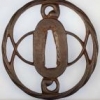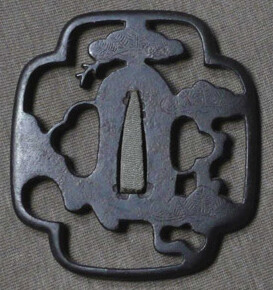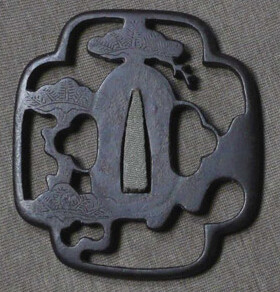-
Posts
323 -
Joined
-
Last visited
Everything posted by lotus
-
David - I will let you know about Tampa, hopefully I can make it. Now, attached are a few close-ups. If there was any doubt about mine being case, I think these photos tell the truth!
-
It would be rather interesting to see a pic of the authentic tsuba that mine was based on, just to see the difference. I am attaching a pic of a tsuba that was attributed to Choshu with the same motif just executed a tad bit differently. It only had the ura side pic. Keith - Thank you very much for your insights. They match with what I am seeing in hand. David - I agree and am hoping to make the Tampa show to further my knowledge. That said, I am learning a great deal right now about how to identify a cast tsuba which is very valuable knowledge for a beginner to have. And perhaps this is helpful for other forum readers as well.
-
Is it the sekagane on mine that is the big flag? This is a good learning experience for me, so I would like to know what else you might be seeing that indicate cast. I will do the magnet test soon and report back. Also, I am going to take a picture of the inside sukashi walls that appear to show a cast seam.
-
The first tsuba attached is mine (at least for the moment) and the second twin tsuba is that of fellow NMB member John L. I stumbled upon his thread from 2010 where there was a brief conversation about his tsuba which can be found here : http://www.nihontomessageboard.com/nmb/viewtopic.php?f=2&t=9056 To summarize that thread, John thought it was Ko-Shoami, Colin questioned the sekigane looking like the same iron as the body, and David said he thought it may be Ko or just early Edo Shoami. That said, if you look closely at both tsuba, you can see some interesting similarities. Dimenstions the same, yep. Seppa dai shape the same, yep. And check out those punch marks, overlapping them in photoshop and guess what? They line up exactly. I mean...exactly. What do you all make of this? Also, it almost looks as if the sekagane is of the same iron and is just carved up to look like a real one? I mean that is what it appears to be. Though John mentioned his was of dark copper?? Maybe mine is to, I am no expert but I have some doubts. There is also another issue about mine I would like to bring up but I would rather wait until tomorrow for that. But who knows, maybe you guys can see what I am hinting at? I will post more pics tomorrow.
-
Mauro - Thanks for sharing that, what a wonderful Tsuba!
-
Thanks Christian, I will check that site out. Do they have an english version of it?
-
Curran - Which dealers do you consider high-end? Just out of curiosity. Might come in handy down the road if I get a large tax refund or win the lotto Thanks for all the info, I have learned lots...
-
The seller is none other than http://www.aoijapan.com (the newer site for http://www.aoi-art.com/) I thought they were reputable. Can anyone comment on this seller? I already requested pictures of the inside sukashi walls and outside of the mimi. Will post back when or if I hear back from them. Those views were suspiciously absent.
-
Saw mention using google that HENKEI means transform. So, could it be the seller is referring to the "transformed" iron finish in reference to it looking melted? Just a wild guess. I agree that it is suspicious looking. If it is a repro, I would have expected it to match the 3 pines design we see in Akasaka/Higo work. You normally see two versions of this design (one abstract and one less so) which I am attaching. The tsuba in question differs from those two designs. Maybe someone has seen a tsuba matching this design?
-
Mauro - At first glance, I was thinking Akasaka (or Higo) as well. However, the thinness does not fit. David - I agree the surface does not look quite right. It appears to me to have that slightly melted finish. As for the very obvious coarseness and texture, I am not sure. Could it be from hammering or more likely a corrosion of some sort over time? The slightly melted surface, thinness (.39 cm), and the older style half moon hitsu-ana are all points in favor of antiquity. However, you guys bring up a good point about the shape of the nakuga-ana. I will research that some more and I eagerly await Curran's post.
-
That is a nice Heianjo tsuba. I saw a similar one on the silk road web site : http://www.silk-road.us/heianjo4.html
-
Yeah, I have a hunch you know the answer!
-
I did some research on the attached Tsuba and have a tentative attribution and my reasons behind it. However, I wanted to ask you guys what you thought for an attribution. The executed motif differs from what you typically see. Here are the details provided to me about this piece : Mei (signature) : Mumei (Unsigned) Length : 8.12 cm x 7.95 cm (3.19 inches x 3.12 inches) Thickness of rim: 0.39 cm (0.15 inches) Jidai(era) : Edo period. Special feature: On the Henkei iron Migaki tsuba, Matsu (pine tree) no zu is engraved with openwork. Jitetsu color is blackish. Thanks!
-
Curran - I really appreciate the info you gave. It is really helpful for me just starting out. The categories you provided are great. I stumbled on another "3 Pine" themed Tsuba that I am very seriously considering. This time, I did my homework and hit my book and the web and feel I have a solid attribution with sound reasons behind them . However, since it is a different piece, I am going to start a new topic on it and see what you guys think for an attribution. It has some interesting differences to other ones sharing the same motif. Thanks again, and I hope to hear your opinions on the new thread. Even if it is to say that it isn't very good ps. David, that is a very cool Tsuba that you posted and I look forward to any feedback you might get.
-
I finally had some time to look into the 1st tsuba a bit more. This is an often used motif called the 3 Pines. You often see it in Higo, Akasaka, and Shoami works. That said, I no longer like either the Akasaka or Higo as an attribution for it. Here are the things that concern me : - Could not locate any Akasaka/Higo samples with that squared off mokko gata (its a bit odd) Typically, on 3 Pines design you see circular shaped rim and often representing part of the tree (bit wavy) or a more rounded mokko as in the Akasaka example I attached (3rd tsuba). - Rim varies in width (wider one one side). Though this may be a design element, I think it is a poor one. - The seppa dai is poorly executed (top is sloppy) - The bottom most tree just seems jammed in (see my attached examples of a proper design). Is the trunk of that tree part of the rim or the trunk on the right of the tree??? Not great, IMO. - Lastly, all good examples of the 3 pines tsuba that I found were so much better (composition and detail) I can't tell much from the iron quality due to the pics. But, with all that said, I simply think this Tsuba is not good enough to be called either Akasaka or Higo. Possibly a late model Shoami copy? Bit of backrgound info, this tsuba was part of Giorgio di Nepi's collection if that means anything to anyone. Any other thoughts?
-
Was looking at a couple Tsuba and wanted your opinions on them. Per the 1st one, the seller attributes this to Akasaka school. Would you agree? And how would one determine if it is early or late Akasaka? Are there some defining characteristics. Also, to me, it also looks like a Higo Nishagaki. Per the second one, the seller has no attribution, but I would venture a guess that it is a late Aizu Shoami piece? This is a guess based on a similar one I found at another site. Look forward to hearing what you all think. Thanks!
-
Thanks for the opinions. It is for sale actually. And yes, it just does not have that look of age to it. Perhpas a very late EDO piece that has been well taken care of or blackened with something? Maybe this is one of those made for export pieces? The scale seems odd as well. Small monkey compared to huge leaves and enormous flowers.
-
This one looks a bit too uniform in color to me and so my first thought was whether it was modern made or not. Can anybody with more experience tell me? Thoughts on a possible school and age would be welcome too. Here are the dimensions (width=7.9cm, height=7.9cm, thickness=5mm) Thanks!
-
-
Thanks Marius. I did also think of Owari and Kanayama. I will definately check out the others you listed as well.
-
What tsuba schools (or artists) produced work that best embody the Zen Aesthetic? By that, I mean things like simplicity, tranquility, elegance, asymmetrical, subtlety, suggestive, naturalness, empty space, direct, and eliminating the non-essentials. Thanks!
-
Thanks for the info guys! Pat
-
Barry - Thanks, I look forward to reading that. Pat
























